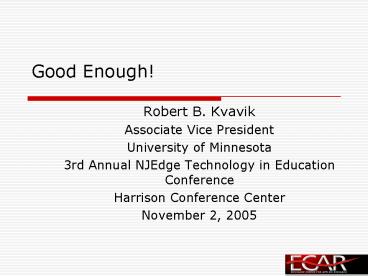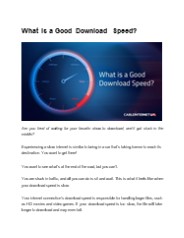Good Enough - PowerPoint PPT Presentation
1 / 49
Title:
Good Enough
Description:
Satisficing. Do the benefits of the optimal process outweigh the ... For many business processes, institutions satisfice. Cross-Process Leading Performers ... – PowerPoint PPT presentation
Number of Views:55
Avg rating:3.0/5.0
Title: Good Enough
1
Good Enough!
- Robert B. Kvavik
- Associate Vice President
- University of Minnesota
- 3rd Annual NJEdge Technology in Education
Conference - Harrison Conference Center
- November 2, 2005
2
Outline
- Context What is Driving Change?
- Study Objectives and Approach
- Overall Findings
- Analytical Framework
- Key Findings by Process
- Role of Technology
- Drivers of High Performance
- Whats Next and Conclusions
3
What is Driving Change?
Fire
Fuel
Budget Cuts
Quality Circles
Regulatory Complexity
Dont Automate, Obliterate!
Enterprise Resource Planning
Rising Customer Expectations
The New Economy
Competition for Resources
Good To Great
Board Expectations
IT Doesnt Matter
4
What is Driving Change?
- Rising customer expectations and demand for
customer convenience and control - Reduction of administrative costs
- Demand for simplicity and transparency in an
increasingly complex environment - Elimination of procedural controls/simplification
of processes
5
What is Driving Change?
- Efficiency
- Effectiveness
- Customer satisfaction
- Reduced business risk
- Accountability
6
What is Driving Change?
- Reduce, eliminate, or transfer costs lower
headcount and/or transaction costs, outsource,
eliminate duplication and facilities - Increase revenue higher yield, new markets and
products/services, higher productivity - Avoid new costs for existing or new services and
functions, transfer effort
7
Efficiency
- More efficient relationships between the
university and students - one-stop self service, linked and automated
transactions - Digitizing and scalability
- digitizing the product or services we provide to
an expanding and use-intensive customer base - Velocity
- the value of speed in the delivery of the product
or services we provide paperless financial aid
8
Effectiveness
- Planning and planned outcomes with strategic
costing of effort - Reporting and performance (yield)
- Rational procedures and policies
9
Satisfaction
- Customer relationship management (CRM)
- Ease of use (LMS)
- Customizing
- customizing the product or service we provide
- students and faculty are expecting new ways of
learning and doing business with the university
10
Study Objectives
- Analyze the state of process performance
- Assess what difference technology makes
- Determine institutional plans for further process
improvement - Identify what differentiates high achievers
11
Where are We and Where are We Going?
Process
Collectively owned
Unit owned
Enterprise-wide system (ERP)
Controlled analysis of public data
Collectively owned
Data
Open analysis of controlled data
Organizational silos
Unit owned
12
First Phase Localized Process Improvement
- Focus on processes within a functional department
- Change processes by simplifying work-steps and
rationalize policies improve form design,
altering office layouts. - Improve hand-offs to other offices
- Historical roles and responsibilities are usually
retained
13
Second Phase Reengineering
- Focus on processes from end to end
- Change processes by eliminating work-steps and
alter policies - Seek to eliminate hand-offs between offices
- Historical roles and responsibilities change
significantly
14
Third Phase ERP-Enabled Process Improvement
- ERP is catalyst for process change
- Redefine end to end process using the automation
and workflow capabilities of the software - Sometimes accompanied by a rethinking of policy
and organizational roles and responsibilities - Begin to decentralize work to the end customer
15
Next Phase Post-ERP Process Improvement
- Emphasis on using the web to promote self-service
- Shift entire responsibility for processing out of
some central departments - Focus on using technology to automatically
trigger services - Need to rethink policies and division of
responsibilities between offices still persists
16
Approach
- Select and define processes
- 48 processes in five areas
- Quantitative survey
- 335 institutions
- Qualitative Interviews
- 32 administrators at 29 institutions
17
Survey Respondents
18
Summary Findings
- Process performance ranges from adequate to
satisfactory - Transactional processes outperform monitoring and
managerial processes - Highest levels of performance in student services
- Lowest in grants management
- Institutions seek to be leaders in processes that
impact recruitment and retention
19
Analytical Framework
20
Optimizing vs. Satisficing
- Optimizing
- What is the best possible way to perform this
process? - Satisficing
- Do the benefits of the optimal process outweigh
the costs of achieving it? - If not, is there a solution that meets base needs?
For many business processes, institutions
satisfice.
21
Cross-Process Leading Performers
22
Cross Process Lagging Performers
23
Cross Process Greatest Change
24
Cross Process Least Change
25
Finance Process Performance
- Institutions ranked themselves between adequate
and satisfied. - Lowest performance was for develop budgets
process. - Highest performance was for small dollar orders
process. - Less than 1 of institutions considered their
processes exemplars.
26
Finance Process Performance
27
HR Process Performance
- Overall institutions ranked themselves as
adequate. - Processes not supported by base ERP packages
performed lower. - More managerial HR processes were poorer
performers. - Few institutions claim to be leaders.
- Few institutions have recently changed their HR
processes.
28
HR Process Performance
29
Student Process Performance
- Reported the highest mean process performance in
the study. - Fewest number of institutions reported student
processes to be at risk. - Recruit students, advising and degree audit
appear to be hardest to change. - Baseline ERP capabilities also shape student
process performance.
30
Student Process Performance
31
Grants Process Performance
- Process performance was barely above adequate and
difficult to change. - No more than 30 of respondents are satisfied
with any of the grants processes. - Three processes were considered at risk by 20
of respondents. - Few institutions are attempting to change their
grants processes.
32
Grants Process Performance
33
Reporting Process Performance
- Overall institutions ranked themselves as
adequate. - Reporting and analysis of the workforce received
the lowest mean performance in the entire study. - Largest percentage were satisfied with enrollment
management reporting.
34
Reporting - Performance
35
Role of IT
- An ERP system (80) and Web self service (68)
were used most often - ERP systems used most often to improve finance
processes (33) followed by HR and student - Web used most often to improve student processes
- Regression analysis reveals the web as the most
important technology
36
Technologies in Use
37
Technologies with Greatest Impact
38
Identifying the High Performers
- Leadership, planning, and technology were the top
3 contributors to process innovation. - Leveraging employee suggestions was the most
important determinant of process performance - Effective use of technology and the ability to
forge cross-functional solutions were key
differentiators among institutions
39
Differentiating Institutional Performance
40
Next Steps
- Current
- Information is the basis of power and is rationed
carefully - Rules driven
- Process driven
- Envisioned
- Common and shared information is the basis of
consensual decision-making - Information driven
- Rules embedded in applications
41
Next Steps
- Current
- Need approvals
- Vertical
- Silos
- Controller
- Culture of anecdotes
- Culture of compliance
- Specialists
- Envisioned
- Empowered people
- Horizontal
- One-stop shopping
- Facilitator
- Culture of information
- Culture of trust
- Generalists
42
Next Steps
- Current
- Locally sub-optimized
- Information is captive and protected
- Services mapped to organizations
- Departmental data/solutions
- Hierarchical/specialized structures
- Envisioned
- Institutionally aligned
- Information is ubiquitous and shared
- Services integrated and seamless
- Enterprise data warehouse solutions
- Open structures and processes
43
Next Steps
- Exploiting the untapped functionality of the ERP
systems - Extending the usefulness of the ERP systems with
new technologies such as portals, workflow, and
others
44
Next Steps
- Continuing standardization of systems,
transactions, and institutional processes - Establishing institutional performance frameworks
and metrics and aligning ERP systems to produce
meaningful performance information
45
Next Steps
- Expanding data warehousing and reporting
capabilities generally - Aligning staff and training to the new
organizational, technical, and service realities
46
Next Steps
- Re-thinking the institutional vision, governance
structures, and interdependencies - Reinvention of organizations and processes
47
Conclusions
- Optimize processes that have the greatest
strategic impact - Conserve resources maintain adequate
performance for commodity processes - Insure that no process is at risk
- Recognize that performance requirements are not
static - Foster a culture of improvement
48
Conclusions
- Rationalize technology investments
- Support commodity processes with commodity
technology - Make targeted investments in differentiating
technologies in strategic areas - Match technology investment with institutional
willingness to change
49
Questions
- Kvavik_at_umn.edu
























![READ⚡[PDF]✔ Enough Already: Learning to Love the Way I Am Today PowerPoint PPT Presentation](https://s3.amazonaws.com/images.powershow.com/10073943.th0.jpg?_=20240706127)
![Download Book [PDF] What If This Were Enough?: Essays PowerPoint PPT Presentation](https://s3.amazonaws.com/images.powershow.com/10087532.th0.jpg?_=20240729051)
![[PDF] Scarcity Brain: Fix Your Craving Mindset and Rewire Your Habits to Thrive with Enough Ipad PowerPoint PPT Presentation](https://s3.amazonaws.com/images.powershow.com/10098818.th0.jpg?_=20240814042)
![get [PDF] Download Never Enough: From Barista to Billionaire PowerPoint PPT Presentation](https://s3.amazonaws.com/images.powershow.com/10100163.th0.jpg?_=20240816063)
![Download Book [PDF] Never Enough: From Barista to Billionaire PowerPoint PPT Presentation](https://s3.amazonaws.com/images.powershow.com/10100165.th0.jpg?_=20240816063)


